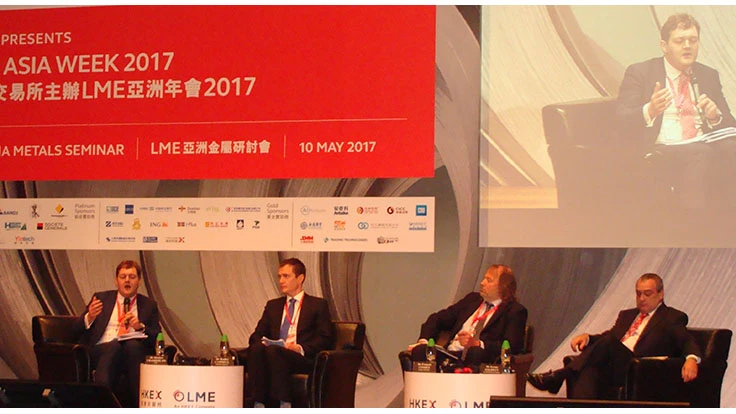
Pictured above, left to right: Matthew Chamberlain of the LME, Bradley Campbell of Standard Chartered, Francois Combes of Société Générale and Jeremy Goldwyn of BANDS Financial.
The price of gold, even more so than that for other metals, can be swayed by the positive or negative mood of traders, said panelists at a session at LME (London Metal Exchange) Asia Week 2017, held in Hong Kong in May.
Gold has long held status as a “safe haven” investment, a trait that is also present in China. China’s demand for gold has been “very robust recently,” said Bradley Campbell, a managing director of metals trading with Hong Kong-based Standard Chartered bank.
Campbell said traditional jewelry demands are part of the picture, but much of the growth is “driven by investment demand,” including in “gold holdings by Chinese banks.”
Francois Combes, global head of commodities markets for Paris-based Société Générale bank, said regarding precious metals trading, “The market is not just spot buying,” adding that gold was being used as an “underlying tool to financing.”
Even with these new sources of demand, the price of gold has been holding steady in the $1,200 to $1,400 per ounce range, said Jeremy Goldwyn of Hong Kong-based BANDS Financial Limited. He said “opportunistic buying” tends to kick in when gold sinks close to the $1,200 mark.
Goldwyn said the gold price is sometimes a “battle” between stability and uncertainty, with geopolitical crises tending to persuade some speculators and investors to buy gold for its safe haven status.
“I suspect this [price] ranging will continue, but can see that average prices will start to escalate,” said Goldwyn. He added, “More likely a [price] breakout would be upwards rather than downwards.”
In the platinum group metals (PGMs) sector, already strong palladium demand may be receiving an assist from the Volkswagen diesel engine scandal, noted Goldwyn.
Diesel engine passenger vehicle have been declining in Europe and around the world since the VW revelation. The catalytic converters that are standard in petrol (gasoline)-powered cars tend to be heavier on palladium than their diesel oxidation catalyst counterparts, according to Goldwyn.
Campbell said the growing car and sport utility vehicle (SUV) market in China provides “a headwind for palladium.” With palladium already in a supply deficit situation, that could point to higher prices for the metal.
Tightness and higher pricing for PGMs in the rest of 2017 likely would also bring positive momentum to the catalytic converter recycling market. Globally, traders and buyers are “seeing some tightness in the palladium markets,” said Matthew Chamberlain, chief executive of the LME.
The LME Asia Week 2017 metal seminar was 10 May at the Hong Kong Convention and Exhibition Centre.
Latest from Recycling Today
- BMW Group, Encory launch 'direct recycling’ of batteries
- Loom Carbon, RTI International partner to scale textile recycling technology
- Goodwill Industries of West Michigan, American Glass Mosaics partner to divert glass from landfill
- CARI forms federal advocacy partnership
- Monthly packaging papers shipments down in November
- STEEL Act aims to enhance trade enforcement to prevent dumping of steel in the US
- San Francisco schools introduce compostable lunch trays
- Aduro graduates from Shell GameChanger program





